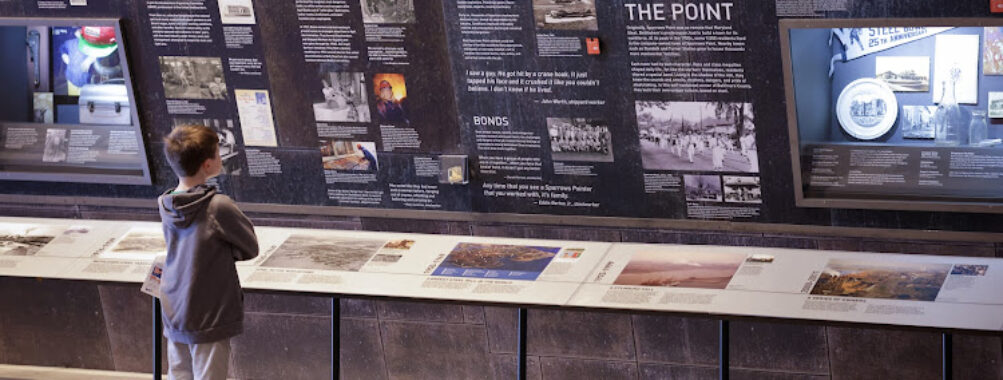
Baltimore Museum of Industry
Table of Contents
The Baltimore Museum of Industry, or BMI as the locals affectionately call it, is one of those places that manage to surprise even lifelong Baltimoreans. This museum doesn’t just showcase artifacts behind glass—it breathes life into the city’s industrial past, exploring how innovation, grit, and good old-fashioned hard work shaped not only Baltimore but much of Maryland’s identity. Housed in a 19th-century oyster cannery building right on the waterfront, the BMI is a love letter to makers, doers, and tinkerers.
What’s most striking is how personal the stories feel. Walking through its galleries, visitors see the legacy of workers, inventors, and entrepreneurs who rolled up their sleeves in shipyards, print shops, canneries, and garment factories long before sleek glass towers lined the Inner Harbor. You can almost hear the clang of machines and smell the faint metallic trace of industry in the air—a sensory reminder that once, these places roared with life.
This museum isn’t some dusty relic, though. It’s bright, interactive, and surprisingly hands-on. Adults and kids alike get to play with the exhibits, learning as they go. I remember spinning a heavy flywheel with my niece during a visit—it took more effort than expected, but the grin on her face was worth every awkward tug. It’s that kind of fun that sneaks in a history lesson when you’re not even trying.
At its core, the Baltimore Museum of Industry reminds visitors that this city has always been more than its famous crabs or baseball team—it’s been a hub of innovation, a birthplace for ideas that fueled the nation’s growth. Whether it’s the old print shop where ink-stained fingers once set type for newspapers, or the recreated 1865 oyster cannery that brings bygone labor to life, each corner echoes with the pulse of determination.
It’s a museum that values stories over statistics, people over product. And that’s probably why so many who wander through end up staying longer than planned, caught in conversation with guides who seem just as passionate about Baltimore’s industrial history as the workers they describe.
Baltimore’s charm shifts with the seasons, and the Baltimore Museum of Industry fits into that rhythm nicely. Spring and fall are prime—pleasant weather means you can stroll along the waterfront before or after your visit without breaking a sweat. Mornings are generally quieter, especially on weekdays. That’s when the museum feels almost meditative, giving you space to wander through exhibits without crowds.
Winter has its perks too. On a chilly afternoon, the warm, brick-lined interior feels especially inviting. It’s also when the museum hosts community programs, maker workshops, or themed events that weave in the festive spirit.
If you prefer energy and buzz, plan to visit during summer weekends. Families, tour groups, and local students fill the halls, and sometimes there are special outdoor displays or live performances near the harbor. Just bring sunscreen and maybe a dose of patience for parking—though, to be fair, that free lot helps a lot.
Getting to the museum is simple enough once you’re in Baltimore. It sits just off Key Highway, which links the Inner Harbor to Locust Point. If you’re driving, follow the waterfront signs—honestly, it’s hard to miss the large smokestack and industrial-style facade. For those relying on public transportation, the Charm City Circulator’s Banner Route stops nearby, and taxis or rideshares drop you right by the entrance.
Some travelers even opt to walk along the harbor from downtown—it’s about a mile or so, and the stroll offers spectacular water views with the city skyline glimmering behind you. If you’re lucky, you’ll spot a freighter gliding past or see rowers cutting through the Patapsco River.
Cyclists can make their way easily too, as there are racks available outside. It’s one of those routes where the journey feels as rewarding as the destination. Especially when there’s a bit of salty breeze coming off the waterfront and the sun hits the old cannery’s windows just right—it’s almost cinematic.
A few lessons from someone who’s been there more than once—and made a few rookie mistakes along the way.
In many ways, the Baltimore Museum of Industry is a reflection of the city itself—hardworking, inventive, unpretentious, and endlessly interesting once you start peeling back the layers. Whether you’re a history buff, a traveler looking to go beyond the usual stops, or just someone who appreciates a good story told well, this place will leave an impression. It’s the kind of museum that pulls you in quietly and sends you back into the Baltimore air thinking about how the work of ordinary people built something extraordinary.
Description
Key Features
Best Time to Visit
How to Get There
Tips for Visiting
Location
Places to Stay Near Baltimore Museum of Industry
Find and Book a Tour
Explore More Travel Guides
No reviews found! Be the first to review!